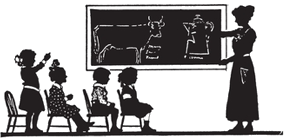In their evaluation of students, writing instructors often assess a portion of students’ final grades as “participation.” For some, “participation” is simply a way of grading attendance or whether or not completed homework is turned in. For others, “participation” means something more, like speaking up in class, taking part in small- and large-group discussions, and/or cooperating during peer review and other in-class activities. In other words, participation is an illusive concept instructors don’t necessarily agree on in practice. It is something, however, that writing instructors strive to Goldiloxx or get "just right."
Genevieve Critel’s work on “participation” sought to understand that illusive concept, what it means to writing instructors, and how it figures into student assessment. She sought to show how writing instructors tried to get participation “just right.” According to Critel’s survey of 148 college writing instructors, 95% reported sometimes or always including participation as part of students’ final course grades. Instructors defined participation as one or more of the following: “attendance, being prepared for class, professional behavior, oral contributions to class, listening, and written contributions in or outside class.” She discovered discussions and instantiations of participation often reflected upon the topoi, or commonplaces, of community, assessment, embodiment, and technology.
This piece furthers Critel’s work on participation by exploring its connection to another commonplace: intellectualism. At a time when critics accuse educational institutions of failing to foster critical thinking or incite intellectual curiosity in students and many label young people ignorant and anti-intellectual, we wondered whether the participation writing instructors were seeking to cultivate and/or assess in their classrooms was a form of intellectualism—or, intellectual participation (IP). And, if so, we wondered what that intellectual participation looked, sounded, and felt like; how it was assessed; and how it weighed in on teachers’ assessments of their teaching practices. We thought about how instructors Goldiloxxed intellectual participation—how they imagined students acting as and being intellectual in “just-right” ways.
To help us answer these questions, we solicited feedback from instructors in the field by inviting them to complete a six-question online anonymous survey. We posted the invitation on the WPA and Techrhet listservs, and solicited our colleagues and professional contacts. In the end, thirty instructors completed the survey. The survey asked instructors what—to them—intellectual participation looks like, sounds like, and feels like; how they assess intellectual participation in their classes; how they communicate their assessment to students; and whether or not they assess their teaching practices based on student intellectual engagement or participation. We intentionally did not define the term intellectual on the survey because we wanted to understand better what, like the illusive nature of “participation,” instructors believe it means in their practices. The survey was presented in the form of a password-protected discussion forum so participants could see each others’ responses and, if they chose, respond to or reflect on them. To maintain participants’ anonymity, they were randomly assigned animal names (squirrel, mongoose, salamander, etc.).
[X]

“By our current methods, we may be training (not educating) a generation of children who are repelled by learning, thinking that it means only drudgery, worksheets, test preparation, and test-taking” (231).
-Diane Ravitch, The Death and Life of the American School System: How Testing and Choice are Undermining Education—2010
[X]
“Growing numbers of students are sent to college at increasingly higher costs, but for a large proportion of them the gain in critical thinking, complex reasoning and written communication are either exceedingly small or empirically nonexistent….They might graduate, but they are failing to develop the higher-order cognitive skills that it is widely assumed college students should master” (121).
-Richard Arum and Josipa Roska, Academically Adrift: Limited Learning on College Campuses—2011
[X]
“The Digital Age has embroiled the young in a swirl of social groupings and contests, and it threatens their intellectual development” (xii).
-Mark Bauerlein, The Dumbest Generation: How the Digital Age Stupefies Young Americans and Jeopardizes Our Future—2009
[X]
“In the choices we have made, consciously or not, about how we use our computers, we have rejected the intellectual tradition of solitary, single-minded concentration, the ethic that the book bestowed on us” (114).
-Nicholas Carr, The Shallows: What the Internet is Doing to Our Brains—2010
[X]
“For a long time now, our public talk about education has been shaped by a concern about economic readiness and competitiveness….We need public talk that links education to a more decent, thoughtful, open society. Talk that raises in us as a people the appreciation for deliberation and reflection, or for taking intellectual risks and thinking widely—for the sheer power and pleasure of using our minds, alone or in concert with others” (25; 28).
-Mike Rose, Why School?: Reclaiming Education for All of Us—2009
[X]
The discussion that occurred among respondents helped us reconceptualize our classrooms in the midst of the buzz surrounding digital technology and calls in our field for educating students to be effective, or "just-right," multimodal communicators. The goal for many instructors is for students to produce successful (however defined) texts in a variety of modes and mediums. For us, this means students produce something similar to what Sherry Turkle observes as the "Goldilocks effect" regarding digital technology. For Turkle technology users get to:
present the self as we want to be. We get to edit, and that means we get to delete, and that means we get to retouch, the face, the voice, the flesh, the body—not too little, not too much, just right.
In other words, online communication allows authors to "Goldilocks" communication. Though Turkle argues the “Goldilocks effect” can be harmful because people come to expect and prefer low-risk, simple connections with others, the outcome of the effect—producing “just-right” texts—is the same goal composition instructors have for their students. For us, then, “Goldiloxxing” intellectual participation in the composition classroom means getting students to produce “just-right” demonstrations of intellectual participation: to look, sound, and create a feeling of intellectual participation in the classroom.




We intentionally designed our six-question survey to encourage instructors to contemplate the sensory nature of intellectual participation and their assessment of it. Previous studies of participation, like Critel’s, have asked instructors to “define” participation. It was our hope that asking instructors to consider how intellectual participation plays out in the sights, sounds, and feelings present in their classrooms would produce a more concrete picture of what they are working to cultivate. Too often, we thought, discussions of participation rely on logos and ethos and overlook the role of pathos, or lived experience. And, too often, surveys are “dead,” private, and don’t allow participants to see how others are responding.
In the instructions for the survey, we invited participants to upload multimedia texts that might help them articulate what intellectualism looks, feels, and sounds like. We also invited them to post multiple comments—to, in fact, treat the survey as a discussion they could participate in during the six weeks the survey was open. We designed the survey with this discussion format because in our experience this survey form leads to more engaged and in-depth responses as participants see what others have written and build off of, contest, and/or qualify others’ responses. Not surprisingly, we also saw this format as possibly modeling intellectual participation in practice. While only one participant uploaded multimedia in their response, a number of respondents referenced others’ comments in their own and some submitted multiple responses.
Though it wasn’t “regular” or “conventional,” our use of animal names for participants’ pseudonyms was meant to be playful, not to dehumanize teachers. In our own classes, we often work to foster participation through an ethos of play. Given the “Goldilocks-and-the-three-bears” metaphor of the piece, animal names seemed playfully relevant and appropriate.
Participants’ descriptions of what intellectual participation looks like are not surprising. In sum, instructors define this form of participation as students thinking critically, engaging actively with ideas and the work of the course, and making meaningful contributions to class discourse (written or oral). It looks active, like students exploring, questioning, creating, contributing, changing positions, challenging, listening actively, talking actively, making connections, taking risks, reflecting, discussing, considering alternative positions, wrestling with materials, collaborating, and moving beyond dualist or binary thinking. Most instructors, like Ocelot, referenced class discussions as “the venue for intellectual participation”; others referenced students’ writing as a physical space where intellectual participation can be seen.
Interestingly, what many instructors describe as intellectual participation in their writing classes sounds like the System 2 thinking defined by psychologist Daniel Kahneman, in Thinking, Fast and Slow. While System 1 thinking is fast, automatic, intuitive, emotional, and requiring little effort, System 2 thinking is the type that is slow, controlled, deliberative, logical, attentive, and effortful. Based on their responses, instructors are looking for the slower, more effortful System 2 thinking as evidence of intellectual participation.
[X]
Similarly, instructors’ descriptions of intellectual participation sound like historian Richard Hofstadter’s idea of intellectualism. Distinguishing between intelligence and intellect, Hofstadter writes, “Whereas intelligence seeks to grasp, manipulate, re-order, adjust, intellect examines, ponders, wonders, theorizes, criticizes, imagines. Intelligence will seize the immediate meaning in a situation and evaluate it. Intellect evaluates evaluations, and looks for the meanings of situations as a whole” (25). While the distinction here is a bit fuzzy, the general interpretation of Hofstadter’s terms is that intellect is a deeper form of thinking and mental work— characteristics listed by survey respondents.
[X]

A number of instructors see intellectual participation even more broadly—as something that happens outside of the classroom and/or goes deeper than mental processes:
These descriptions accord with Hofstadter’s definition of an intellectual as someone who “lives for ideas, not off them," is dedicated to “the life of the mind,” and has the desire to keep asking questions (27-31). While instructors made no mention of turning their students into intellectuals, the intellectual participation they are working to cultivate in their classes indicates they’re hoping to inspire a relationship with ideas similar to the one described by Hofstadter.

If the action of intellectual participation in a writing classroom looks like students demonstrating System 2 thinking and/or intellectualism in classroom discussions, in their writing, and/or in their lives at large, we wonder if the absence of these actions (or resistance to these actions) gets read by teachers or society as the ignorance and anti-intellectualism so many critics attribute to young people. On a small scale, is a student’s failure to demonstrate intellectual participation in our classrooms evidence they are “repelled by learning” (Ravitch), “failing to develop…higher-order cognitive skills” (Arum and Roska), rejecting “solitary, single-minded concentration” (Carr), or enacting “a resentment and suspicion of the life of the mind” (Hofstadter)? Conversely, are students who look like they are participating intellectually (as the instructor defines it) actually intellectual, or prointellectual? Or, are they performing intellectual participation based on the actions they see their teachers rewarding?

Such questions raise the issue of assessment. How can we/do we assess intellectual participation, particularly based on what it looks like? A number of instructors stated in their survey responses that it’s difficult to quantify or impossible to assess fairly, especially because it is hard to see, and as some contend, can vary from student to student, teacher to teacher, and situation to situation.
[X]
Overall, though, instructors’ list of actions they do assess as intellectual participation include one or more of the following: attendance, coming to class prepared, completing assignments, in-class participation (through body language and/or verbal contributions), demonstrating thoughtful reflection/making meaningful contributions (verbally or in writing).
We found it interesting that a few instructors mentioned body language among the actions they assessed as a demonstration of IP. For these instructors, then, students need to look like they are participating intellectually by having “physical attitude,” “physical attentiveness,” and “body language” that are "just right." We wonder to what extent these physical behaviors are the product of genuine intellectual engagement and to what extent they are the result of students playing the part of the intellectual, engaged student. In addition, as Critel and Margaret Price remind us, the physical embodiment of participation teachers envision is often ableist, and therefore exclusionary.
[X]
As with writing or any composition, enacting intellectual participation (visually) takes practice to get “just right.” Our students write, rewrite, edit, receive feedback, and write some more to become “just-write” writers (pun intended). In this way, our assessment of intellectual participation as it appears in students’ writing is more explicit, and students are being taught how to be increasingly successful at it. We wonder why “composing” ourselves as “intellectual participants” (via body language) would be a different process. To look like someone engaging in intellectual participation means understanding the rhetorical situation and making rhetorical maneuvers that communicate you can physically “play” the intellectual. It means participating in and being instructed in the process of communicating physically (through body language), rethinking, editing, receiving feedback, and recomposing your physical/body language. If we are assessing these physical compositions, shouldn’t we also be teaching them, and telling students they are being assessed?


Understanding what intellectual participation looks like to instructors gave us an idea of how it might sound in the classroom. Since intellectual participation was most often defined by actions, it made sense, then, that a majority of participants described intellectual participation as sounding active.
[X]
In contrast, a number of instructors mentioned intellectual participation may in fact sound quiet or like SILENCE. They explained how much of the intellectual work of intellectual participation happens in the mind and may not require or include verbal participation.
[X]
Some instructors even describe the sounds of intellectual participation as encompassing
both sound and silence.
[X]
The action instructors associate with the sound of intellectual participation is most often conversation/discussion:
As one can gather, it’s impossible to get the sound of intellectual participation “just right.” Is a noisy classroom a sign of intellectual participation? Is a silent classroom? What combination might ring best in a teacher’s ear? Based on the responses we received, Aardvark had it right when they said, “Intellectual participation doesn't sound like any one thing."

Turkle, in her critique of digital communication practices, calls for a revival of conversation— a revival of messy interactions between people that may not be "just right." Here we agree with Turkle in her call for us to engage with each other in ways that aren't "just right" though not for the same reasons. We believe conversation —both face to face and online—is something important that should be addressed in the classroom and treated as an important rhetorical text that one can get "just right." Making the sounds of intellectual participation, in other words, takes practice. Some respondents commented on this need, arguing students must be taught how to perform the actions their teachers are valuing and assessing.
[X]
Wildebeest and Fossa even included templates showing the rhetorical moves for the types of conversations that sound like intellectual participation to them.
[X]
While texts like Gerald Graff and Cathy Birkenstein’s They Say/I Say: The Moves That Matter in Academic Writingteach academic writing as a type of conversation using similar templates, the emphasis in the text is on how students enter these conversations in writing. Based on responders’ feedback, we believe oral conversation should be among the rhetorical tools we teach.
45% of participants mentioned silence and/or listening was important for IP.


Cynthia Selfe would support our call to conversation—to pay attention to aurality as it is "often undervalued as a compositional mode" (617). In her work, she observes how higher education shifted from valuing aurality and oratory as important modes of instruction—the "older style of education" (621)—towards valuing the written word and writing as THE mode of instruction "based primarily on the study and analysis of written texts, both classical and contemporary—and the production of such texts" (621). Selfe offers suggestions for introducing aurality and other modes of communication into the classroom and asks us to look at the affordances and constraints of such texts, but her focus is primarily on creating texts that one has time to prepare (i.e., "songs and lyrics, videos, written essays illustrated with images, personal Web pages that include sound clips" (642)). Though she does mention Diana George's work on peer-group discussion where "oral exchanges were considered as semiotic texts that were composed and could be studied for the meaning they contained" (633), for the most part, Selfe does not discuss the evanescent and fleeting communication of many face-to-face and online conversations.
For us, it seems that conversation in a variety of forms is often overlooked as a rhetorical act and as a rhetorical situation. It seems that instructors assume students understand the affordances and constraints of conversational technologies. It seems that we may assume students come into our classrooms with knowledge in dialogue and discussion.
Respondents’ comments about what intellectual participation sounds like also reminded us of Mary Reda’s work on student silence. In Between Speaking and Silence, Reda argues that in our efforts to embody the image of the “great teacher” as a discussion leader who inspires students’ “passion, intellect, self-reflection, personal growth, and political awareness,” we often perpetuate an image of the “good student” as a “vocal, ‘active’ student whose classroom activity is an integral part of the construction of knowledge” (4). To this end, we end up valuing and rewarding the “vocal” students in our classrooms and dismissing student silence as anti-intellectualism or as anti-intellectual participation. While student silence may sometimes indicate these attitudes, it may also, as some respondents mentioned, indicate students are engaging in a silent form of intellectual participation:
How, then, do we fairly assess the sounds of intellectual participation?
A sample of survey responses indicates instructors are listening for different things and different levels of oral contributions to class discussions. Once again, it’s important for teachers to communicate to students how they are assessing student participation. For this reason, our survey asked participants how they communicate their assessment of intellectual participation to students. A majority of instructors stated they have a policy or statement of expectations on their syllabus that they review with students. Some instructors said they follow this with rubrics; some model or provide examples of intellectual participation as they define it; others mentioned giving students feedback on their papers and/or in person; and still others said they try to validate strong student contributions and urge students to dig deeper with their questions and comments. This last method appears to be the primary way in which instructors try to encourage the sound of intellectual participation in their classrooms: praise and validate strong oral contributions and ask questions that help students produce productive oral contributions. We wonder if this method ends up producing (and rewarding) System 1 thinking rather than System 2 thinking, particularly if it encourages spontaneous, fast, emotional contributions.
[X]
The issue of assessing the sound of intellectual participation made us reflect on our own efforts to demonstrate “good teaching.” We found that when we’re being observed by colleagues we work to showcase the noisy, rather than the quiet, form of intellectual participation; we’ve also noticed in our observations of other teachers that they appear to be working to produce a similar-sounding classroom. In this way, it seems that, as instructors, we are rewarded for—or at least we imagine we are rewarded for—being instructors who can “bait” students into System 1 oral performances.

One way we believe composition instructors who value intellectual participation and multimodality can address the sounds and silences of intellectual participation in the classroom is by examining the affordances and constraints of conversation. For us, there should be more discussion and analysis in our classrooms about the rhetorical maneuvers one can make in conversation. In other words, how is conversation directed by audience, kairos, and decorum? How do filler words help us buy time for a response? What fillers are appropriate for different situations? How does turn taking function? Is interruption appropriate in this situation? When is silence appropriate?

 Skip to main content.
Skip to main content.Like their descriptions of what intellectual participation looks like and sounds like, responders acknowledged it can feel “differently for different participants.” In fact, Wombat argued it “should feel different every time because it is an organic experience.” A majority of respondents, however, stated it feels exciting and energizing.
A number of responders described it as a movement between feeling uncomfortable or unsettled and feeling comfortable, familiar, or in “flow.”
[X]
Some participants described how it feels for them, specifically, as teachers.
One respondent acknowledged intellectual participation doesn’t appear to happen often for students, but that teachers can aid in creating opportunities for it to happen in their classrooms.
[X]


The metaphor we found resonated most with teachers’ descriptions of what intellectual participation feels like is an intellectual orgasm. We use the term here as it is defined by the Urban Dictionary: “to enjoy a high-level or intelligent conversation to the maximum”; “when you hear something that is so profound, brilliant, or novel, that it blows your mind.” The feeling associated with “a good” and intellectually participatory class is, for many instructors, orgasmic in this sense. It’s a sensual experience in which the discussion and/or intellectual work of the class peaks with a mind-blowing feeling. For some, this feeling is followed by a “crash” of sorts when the class ends.
We wonder, though, if these classes are intellectually orgasmic because we’ve System 1’ed our students (brought out their intuitive, emotional reactions to the material) rather than cultivated the development of slow, deliberative, effortful System 2 thinking. While we don’t mean to suggest there is nothing worthwhile about such System 1 interactions, we wonder if our ideas of intellectual participation send mixed messages. Do we feel most successful as teachers when we foster System 1 thinking in our classes but expect (as in the discussion of what intellectual participation looks like) System 2 thinking? Do we look for System 2 thinking, but reward students for the feeling System 1 emotional thinking gives us?
When asked whether they self-assess their teaching based on student intellectual engagement or participation and if so, how so, all instructors said yes except one person who wrote, “not formally aside from evaluations.” We were struck by the comments indicating instructors judge their success as teachers (i.e. feel good or bad about their teaching) based on student engagement in the classroom.
[X]
For us, experiencing intellectual participation as orgasmic is an unfortunate problem in our profession. To have embodied what constitutes intellectual participation or “good” teaching as something in which we have successfully “blown students’ minds” in order to feel like we’ve done our jobs well in these sorts of classes means every other class feels like a failure, or a letdown. There is no way any amount of effort will, in fact, allow instructors to foster "mind-blowing" learning every time. Yet we seem to put that expectation on ourselves. In other words, to persuade ourselves, perhaps our students, and outside observers (i.e. those reviewing our classes for our continued employment and/or tenure review) that, yes, we are good at our jobs, we place unfair expectations on ourselves and our audiences. We forget that, just as with composing other texts, to get to that “feeling” more often (i.e. to increase the chances of that “mind-blowing” experience) students need instruction in the rhetoric of intellectual participation. We must remember that intellectual orgasms take practice, experience, and a little bit of kairos (a rhetorical term that needs to be reconsidered as lucky). We must remember all the variables that go into making a class orgasmic (i.e., students have done the reading, understand the reading, are alert, are interested, aren’t intimidated by each other, have practiced IP, the instructor is asking the questions in a way that’s working today; etc.).

There needs to be a balance between what we feel and how we feel in the classroom and what is being learned/assessed. Our classrooms may very well be student centered in spaces where students or learners are cooperating and engaging in active learning and problem solving. If part of how we measure the success of our teaching, however, is based on our fostering a mind-blowing experience, are our assessment measures more teacher centered than student centered? As Chinchilla pointed out, it’s difficult to self-assess based on students’ intellectual engagement because, “students sometimes try to please or reflect back what they think you want to see/hear/do.” In other words, they perform. In addition, Sturgeon raised the complex issue of who can or should get credit for the success (or lack of success) of intellectual participation: “Is it possible [to assess intellectual participation] without being way too personal and perhaps self-gratifying when all seems to go well? When it doesn’t go well, can I always fault the students?” Assessing our success as teachers based on whether we feel intellectual participation in the classroom, consequently, can be dangerous and lead to a false sense of the effectiveness of our teaching practices.


While our findings based on the responses of thirty writing instructors are not conclusive, they do point out some important tensions we think the field of rhetoric and composition should examine more closely. First, we need to understand better what we (individually and collectively) are looking to create in our classrooms when we try to foster intellectual participation among students. As our survey showed, while there is much agreement from respondents about what intellectual participation looks, sounds, and feels like, there is not a consensus. While this lack of consensus on the “just right” of intellectual participation may not be an altogether bad thing, it does indicate teachers must communicate clearly to students what behaviors they are looking for and which they are assessing.
This also means we must teach students to understand the rhetoric of intellectual participation—to recognize it as a rhetorical maneuver they can (and may need to) perform in this and/or other situations. Students, in other words, must consider the rhetorical situation and the means of persuasion to communicate themselves as intellectual participants. For instance, students’ moves might include asking engaging questions, practicing turn taking and follow-up questioning, using discussion templates or models, vocalizing deep thinking, pondering (quietly, perhaps), projecting energy and enthusiasm, and positioning their bodies as engaged, interested listeners/learners.
Additionally, given the pervasive rhetoric of anti-intellectualism and ignorance in United States culture, we may do well to include an examination of this rhetoric in our discussions of intellectual participation with students. We can invite them to consider in what ways critics like Hofstadter, Arum and Roska, Carr, Bauerlein, Ravitch, and Rose are correct in their assessments of American education and intellectualism and in what ways they are wrong. Such dialogue is an avenue for discussion about the benefits of intellectual participation, particularly the benefits for students themselves. In what ways does intellectual participation make them better students? Better learners?


We feel it is necessary to strike a balance between understanding the persuasive moves in being intellectually participative and connecting these moves to genuine intellectual participation. There are a number of questions we should begin asking ourselves as writing instructors: Why are we trying to foster intellectual participation in our classes and why, consequently, are we rewarding some actions over others (System 1 thinking vs. System 2 thinking; intellectualism vs. intelligence; conversation vs. silence; discomfort vs. comfort)? What do we hope to gain with our attention to these actions? What do we lose when we reward some actions over others? How, ultimately, does intellectual participation as we define it help us attain student learning outcomes and meet the goals of the course? We must force ourselves to reflect on whether making intellectual participation a goal of the course is for our benefit or for students’. In other words, are the actions we associate with intellectual participation student centered or teacher centered? Do they help us assess teachers’ teaching or students’ learning? It’s plausible that our expectations of ourselves as successful and our assessments of students as successful may foster the performance of intellectual participation more than cultivate genuine intellectual participation among students.
This research represents what we hope is the beginning of more research into the issue of intellectual participation and expectations of intellectualism in the writing classroom for teachers and for students. We wonder what intellectual participation looks, sounds, and feels like to students; how they assess it; and whether or not they assess themselves as students based on their perceived performance of it. We have much to learn as a field from better understanding the connections between our own and our students’ definitions, expectations, and assessments of intellectual participation. And, as Critel concluded, because “participation requirements function to communicate to students something about what it means to perform the role of student,” we must contemplate what our expectations for intellectual participation are telling students it means to be a student. 
Arum, Richard, and Josipa Roska. Academically Adrift: Limited Learning on College Campuses. U of Chicago P, 2011.
Bauerlein, Mark. The Dumbest Generation: How the Digital Age Stupefies Young Americans and Jeopardizes Our Future. Penguin Books, 2009.
Carr, Nicholas. The Shallows: What the Internet is Doing to Our Brains. W.W. Norton, 2010.
Critel, Genevieve M. “Investigating The Rhetoric of Student Participation: Uncovering and Historicizing Commonplaces in Composition Studies.” Diss. The Ohio State U, 2012.
Graff, Gerald and Cathy Birkenstein. "They Say/I Say": The Moves That Matter in Academic Writing. 2nd ed., W.W. Norton, 2007.
Hofstadter, Richard. Anti-intellectualism in American Life. Knopf, 1963.
"Intellectual orgasm." Urban Dictionary. 2006, http://www.urbandictionary.com/define.php?term=intellectual+orgasm.
Kahneman, Daniel. Thinking Fast and Slow. Farrar, Straus, and Giroux, 2011.
Price, Margaret. Mad at School: Rhetorics of Mental Disability and Academic Life. Univ. of Michigan P, 2011.
Ravitch, Diane. The Death and Life of the American School System: How Testing and Choice are Undermining Education. Basic Books, 2010.
Reda, Mary M. Between Speaking and Silence: A Study of Quiet Students. State U of New York P, 2009.
Rose, Mike. Why School?: Reclaiming Education for All of Us. The New Press, 2009.
Selfe, Cynthia L. “The Movement of Air, The Breath of Meaning: Aurality and Multimodal Composing.” College Composition and Communication, vol. 60, no. 4, 2009, pp. 616-63.
Turkle, Sherry. "Connected, but Alone." Ted, Feb. 2012, https://www.ted.com/talks/sherry_turkle_alone_together?language=en&utm_source=tedcomshare&utm_medium=referral&utm_campaign=tedspread-a
The following images come from - Harter, Jim. Animals: 1,419 Copyright-Free Illustrations of Mammals, Birds, Fish, Insects, etc. Dover Pictorial Archive, Dover Publications, 1979. (Name and image number are provided.)
Name and image number are provided - Bears (174, 175), Common European Bear (181), Dodo (543), Domestic Fowl (121), Giant Anteater (364), Horned Owl (476), Spotted Salamander (935), Tarsier (36), and Various Bats (424).
The following images come from - Grafton, Carol Belanger. Children: A Pictorial Archive Dover Pictorial Archive, Mineola, Dover Publications, 2002. (Plate and image number are provided.)
Plate 80 image 757 (girl pulling covers next to wolf), Plate 86 image 809 (girl hugging bear), and Plate 91 image 855 (children sledding).
The following images come from - Cabarga, Leslie, and Marcie McKinnon. Lively Advertising Cuts of the Twenties and Thirties: 1,102 Illustrations of Animals, Food and Dining, Children, etc. Dover Pictorial Archive, Dover Publications, 1990. (Kindle location is provided.)
Location 59 (teacher, students, and chalkboard) and Location 60 (woman teaching students how to figure skate).
The following images come from iStock:
DavidBukach. 19th century engraving of a chinchilla. iStock, 2010, http://www.istockphoto.com/
denisk0. Reindeer. iStock, 2012, http://www.istockphoto.com/.
---. Darwin's mouse. iStock, 2013, http://www.istockphoto.com/.
nicoolay. Indian Cobra. iStock, 2009, http://www.istockphoto.com/.
The horizontal scrolling design used in this text was based on this article and demo -
Mary Lou. "Smooth Vertical OR Horizontal Page Scrolling with jQuery" codrops. Tympanus, 2 June 2010, https://tympanus.net/codrops/2010/06/02/smooth-vertical-or-horizontal-page-scrolling-with-jquery/
The accordion list design used in this text was based on this article and demo -
Coyier, Chris. "Simple jQuery Accordion." CSS-Tricks, 13 Aug. 2013, https://css-tricks.com/snippets/jquery/simple-jquery-accordion/
The typefaces used are Palatino Linotype and Amatic SC Regular (found on FontSquirrel) and created by Vernon Adams.
We would like to thank Andrea Briggs and Shane McCracken for inspiring our design. Their web design work in Multimedia Authoring helped us imagine the interface.